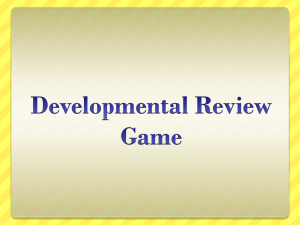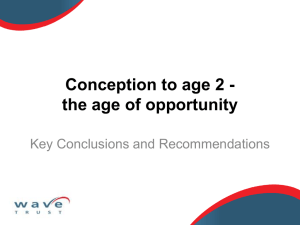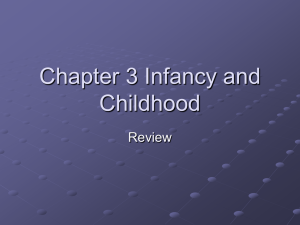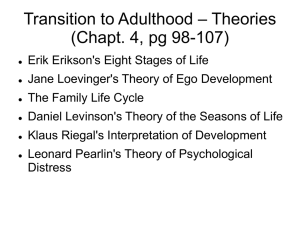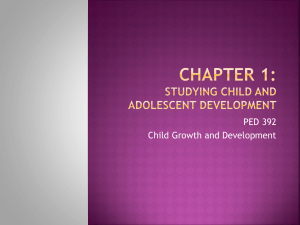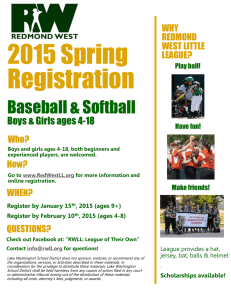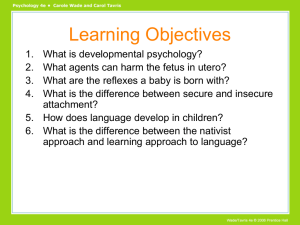Health Promotion of the Newborn and Family
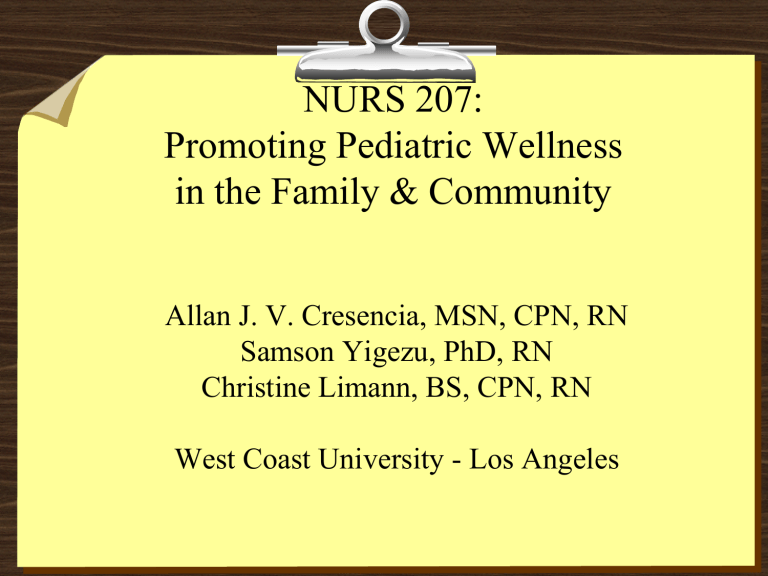
NURS 207:
Promoting Pediatric Wellness in the Family & Community
Allan J. V. Cresencia, MSN, CPN, RN
Samson Yigezu, PhD, RN
Christine Limann, BS, CPN, RN
West Coast University - Los Angeles
Theories of Development
• Personality Development
•
Freud - Psychosexual
• Erickson - Psychosocial
•
Mental Development
•
Piaget - Cognitive
•
Kohlberg - Moral
Erikson Stages of
Psychosocial Development
1.
Infancy
: Birth to 18 Months
Ego Development Outcome: Trust vs. Mistrust
Basic strength: Drive and Hope
2. Toddler :
18 Months to 3 Years
Ego Development Outcome: Autonomy vs. Shame
Basic Strengths: Self-control, Courage, and Will
3. Preschooler : 3 to 5 Years
Ego Development Outcome: Initiative vs. Guilt
Basic Strength: Purpose
Erikson Stages of Psychosocial
Development
4.
School Age
: 6 to 12 Years
Ego Development Outcome: Industry vs. Inferiority
Basic Strengths: Method and Competence
5.
Adolescence
: 12 to 18 Years
Ego Development Outcome: Identity vs. Role Confusion
Basic Strengths: Devotion and Fidelity
Theories of Development
•
Piaget – Mental
•
Sensorimotor – birth to
2 years
• Preoperational – 2 to 7 years
• Concrete operations – 7 to 11 years
• Formal operations – 11 to 15 years
•
Kohlberg – Moral
•
Preconventional level – good/bad or right/wrong
• Conventional level – approval by being “nice”
• Postconventional, autonomous, or principled level – formal operations
Piaget Stages of Cognitive Development
Sensorimotor period Years 0-2
In this stage, infants construct an understanding of the world by coordinating sensory experiences (such as seeing and hearing) with physical, motoric actions.
Infants gain knowledge of the world from the physical actions they perform on it.
An infant progresses from reflexive, instinctual action at birth to the beginning of symbolic thought toward the end of the stage.
Object permanence is key word.
Infant Stimulation
•
Newborn prefers human face for stimulation
•
Visual benefit of black-andwhite objects for stimulation
•
Stimulation of human voice
•
Importance of tactile stimulation
Focus on Visual Objects
Fine Motor Development
•
Grasps object, age 2 to 3 months
•
Transfers object between hands, age
7 months
•
Pincer grasp, age 10 months
•
Removes objects from container, age
11 months
•
Builds tower of two blocks, age 12 months
Crude Pincer Grasp
Neat Pincer Grasp
Gross Motor Development
•
Head control
•
Rolls over, age 5 to 6 months
•
Sits alone, age 7 months
•
Moves from prone to sitting position, age
10 months
Head Control
Locomotion
•
Cephalocaudal direction of development
•
Crawling, age 6 to 7 months
•
Creeping, age 9 months
•
Walk with assist, age 11 months
•
Walk alone, age 12 months
Psychosocial Development
• Erikson’s phase I: developing a sense of trust
•
Trust vs. mistrust
•
Importance of caregiver-child relationship
• “Delayed gratification”
•
Importance of consistency of care
Finding Hidden Object
Development of Body Image
•
Concept of object permanence
•
By end of first year, recognize that they are distinct from parents
Viewing Own Image
Development of Sexual Identity
•
Hormonal influences
•
Infant
•
Parental influences on development of sexuality
Social Development
•
Attachment
•
Reactive attachment disorder (RAD)
•
Separation anxiety
•
Stranger anxiety
•
Play as major socializing agent
Stranger Fear
Language Development
•
Crying is first verbal communication
•
Vocalizations
•
Three to five words with meaning by age
1 year
Infant’s Health Promotion
• Promoting Infant Safety
•
Aspirations
•
Falls
• Car (MVA)
• Siblings
• Bathing and Swimming
•
Childproofing
Infant’s Health Promotion
•
Nutritional Health
•
Recommended dietary reference intakes
• Introduction of solid foods
• Loss of extrusion reflex
•
Techniques for feeding solid foods
•
Nutritional Health
•
Quantities and types of food
• Cereal
• Vegetables and fruit
• Meat and eggs
• Table food
• Chart on next slide.
Infant’s Health Promotion
• Nutritional Health
•
Establishment of healthy eating patterns
•
Weaning
•
Self-feeding
• Adequate intake with a vegetarian diet
• Development in Daily
Activities
• Bathing
•
Diaper-area care
•
Use of pacifiers
•
Care of teeth
•
Dressing
• Sleep patterns
• Exercises
Infant’s Health Promotion
•
Parental Concerns and
Problems
• Diaper dermatitis – skin condition
• Miliaria – sebaceous glands
•
Baby-bottle syndrome – dental carries
•
Obesity – no comment!
Baby-bottle syndrome – dental carries
Health Problems During Infancy
Chapter 13
Protein and Energy Malnutrition
•
Kwashiorkor
Severe protein malnutrition, especially in children after weaning, marked by lethargy, growth retardation, anemia, edema, potbelly,
•
Marasmus
A progressive wasting of the body, occurring chiefly in young children and associated with insufficient intake or malabsorption of food
Food Sensitivity
• Cow’s milk allergy
•
Lactose intolerance
Feeding Difficulties
• Regurgitation and “spitting up”
•
Reflux/GERD
•
Colic (paroxysmal abdominal pain)
•
Failure to thrive
•
Organic FTT
•
Nonorganic FTT
The “Colic Carry”
A Consistent Nurse in
Nonorganic FTT
SKIN DISORDERS
Diaper Dermatitis
•
Principal factors in development
•
Therapeutic management
•
Nursing considerations
Seborrheic Dermatitis
•
Chronic, recurrent, inflammatory reaction of the skin
•
Scalp: cradle cap
• Eyelids: blepharitis
•
External ear: otitis externa
•
Cause unknown
•
Nursing considerations
•
Head & Shoulders to wash hair 1-2 times
Atopic Dermatitis
•
Also called eczema
•
Is a category of dermatologic diseases and not a specific etiology
•
Pruritic
•
Usually associated with allergy
•
Hereditary tendency
Atopic Dermatitis-
Therapeutic Management
•
Hydrate the skin
•
Relieve pruritus
•
Reduce inflammation
•
Prevent and control secondary infection
•
Nursing considerations
Disorders of Unknown Etiology
•
Sudden infant death syndrome (SIDS)
•
Apparent life-threatening events
(ALTEs)
• “Back to Sleep” campaign
•
Increased incidence of positional plagiocephaly
Infants at Risk for SIDS
•
Unknown Etiology
•
Infants with one or more severe Apparent life-threatening events (ALTEs) requiring
CPR or vigorous stimulation
•
Preterm infants experiencing apnea at time of discharge from hospital
•
Sibling of two or more SIDS victims
•
History of central hypoventilation
Health Promotion of the
Toddler and Family
Biologic Development
•
Weight gain slows to 4 to 6 pounds per year
•
Birth weight should be quadrupled by
2½ years of age
•
Height increases about 3 inches per year
• Growth is “steplike” rather than “linear”
Maturation of Systems
•
Most physiologic systems relatively mature by the end of toddlerhood
•
Upper respiratory infections, otitis media, and tonsillitis are common among toddlers
•
Voluntary control of elimination
•
Sphincter control age 18 to 24 months
Gross and Fine Motor
Development
•
Locomotion
•
Improved coordination between ages 2 and 3
•
Fine motor development
• Improved manual dexterity ages 12 to 15 months
•
Throw ball by age 18 months
Typical Toddling Gait
Psychosocial Development
•
Erikson: developing autonomy
• “Autonomy” vs. “shame and doubt”
• “Negativism”
• “Ritualization” provides sense of comfort
•
Id, ego, superego/conscience
Promoting Optimum
Growth and Development
• “The terrible 2s”
•
Ages 12 to 36 months
•
Intense period of exploration
•
Temper tantrums, obstinacy occur frequently
•
Developing independence vs. parental control
Piaget Stages of Cognitive
Development
Preoperational period (years 2 to 6)
Learn spatial relationships
Awareness of causal relationships between two events
the child learns to use and to represent objects by images, words, and drawings
The child is able to form stable concepts as well as mental reasoning and magical beliefs
Thinking is still egocentric: The child has difficulty taking the viewpoint of other
Moral Development
•
Kohlberg: preconventional or premoral level
•
Punishment and obedience orientation
• “Time out” is useful at this age
-1 minutes per year of age
Development of Body Image
•
Refer to body parts by name
•
Avoid negative labels about physical appearance
•
Recognize sexual differences by age 2
Development of Sexuality
•
Exploration of genitalia is common
•
Gender roles understood by toddler
• Playing “house” or “pirates”
Social Development
•
Differentiation of self from mother and from significant others
•
Separation
•
Individualization
Language
•
Increasing level of complexity
•
Increasing ability to understand
Personal Social Behavior
•
Toddlers develop skills of independence
•
Skills for independence may result in tyrannical, strong-willed, volatile behaviors
•
Skills include feeding, playing, and dressing and undressing self
Playing Dress-Up
Transitional Objects Provide
Security
Play
•
Magnifies physical and psychosocial development
•
Parallel play
•
Imitation
•
Locomotive skills
•
Tactile play
Coping with Concerns Related to
Normal Growth and
Development
•
Toilet training
•
Sibling rivalry
•
Temper tantrums
•
Negativism
•
Regressive behavior
Toilet Training
Assessing Readiness for Toilet Training
•
Voluntary sphincter control
•
Able to stay dry for 2 hours
•
Fine motor skills to remove clothing
•
Willingness to please parents
• Curiosity about adult’s or sibling’s toilet habits
•
Impatient with wet or soiled diapers
Promoting Optimum Health
During Toddlerhood
•
Nutrition
• Phenomenon of “physiologic anorexia”
•
Sleep and activity
•
Dental health
•
Regular dental exams
•
Removal of plaque
•
Fluoride
•
Low-cariogenic diet
Toothbrushing
Injury Prevention
•
Motor vehicle injuries: car seat safety
•
Drowning
•
Burns
•
Poisoning
•
Falls
•
Aspiration and suffocation
•
Bodily damage
Forward-Facing Convertible
Seat
Matches Are a Potentially
Deadly Hazard
Plastic Caps for Electrical Sockets
Storage of Cleaning Agents
Health Promotion of the
Preschooler and Family
PROMOTING OPTIMUM
GROWTH AND DEVELOPMENT
•
Preschool period
•
3 to 5 years of age
•
Refining tasks mastered in toddlerhood
Biologic Development
•
Physical growth rate slows and stabilizes during preschool years
•
Physical proportions change
•
Slender but sturdy
• Graceful, agile
•
Posture erect
•
Males and females similar in size and proportion
Gross Motor Behavior
•
By 36 months:
• Walking, running, climbing, jumping
•
By age 4 years:
•
Skips and hops on one foot
• Catches ball
•
By age 5 years:
•
Skips on alternate feet, jumps rope, learns to skate and swim
4-Year-Old Hops on One Foot
Psychosocial Development:
Erikson
•
Developing a sense of initiative
•
Initiative vs. guilt
•
Development of superego (conscience)
(Freud)
Cognitive Development: Piaget
Preoperational phase—ages 2 to 7
Preconceptual phase: ages 2 to 4
Intuitive thought: ages 4 to 7
* Causality
* Time
* Magical thinking
* Logical thinking
Moral Development: Kohlberg
•
Preconventional (premoral)
• Punishment and obedience orientation: ages
2 to 4
• Naïve instrumental orientation: ages 4 to 7
Preschoolers Enjoy Friends
Spiritual Development
•
Parental influences
•
Concrete representation of spiritual beings
•
Development of conscience related to spiritual development
Development of Body Image
•
Increasing awareness of self and others
•
Poorly defined body boundaries
•
Poor understanding of internal anatomy
Development of Sexuality
•
Sexual identity
•
Sexual beliefs
•
Sex typing
•
Gender behaviors
•
Sexual exploration of children is main health concern
Social Development
•
Individuation-separation process
•
Effects of prolonged separation (such as hospitalization)
Language
•
Ages 4 to 5: four- and five-word sentences
•
Age 6: understand all parts of speech; identify opposites
Preschooler Dressing Himself
Personal-Social Behavior
•
Self-assertion is a major theme
•
Independent in dressing, eating, toileting by ages 4 to 5
•
Desire to please
•
Internalized values--conscience & morals
•
More secure with new sibling arrival at this age
Play
•
Associative play
•
Make up rules as they go along
•
Imitation
•
Imaginary playmates
•
Mutual play with parents
Preschoolers Enjoy a Sense of
Accomplishment
Preschoolers Enjoy Imaginative and
Imitative Play
Coping with Concerns Related to
Normal Growth and
Development
Preschool and
Kindergarten Experience
•
Learning group cooperation
•
Peer group experiences
•
Readiness for academics
•
Preparing the child
Sex Education
•
Find out what the child knows and thinks
•
Be honest with responses
•
Understanding the broader concept of sexuality
•
Resources:
• Sexuality Information and Education Council of the United States (SIECUS)
• American Academy of Pediatrics (AAP)
Aggression
•
Definition: behavior to hurt person or destroy property
•
Frustration
•
Modeling
•
Reinforcement
•
Professional help for parenting
Fears
•
Night terrors
•
Animism: ascribing lifelike characteristics to inanimate objects
•
Techniques to overcome fears
PROMOTING OPTIMUM
HEALTH DURING THE
PRESCHOOL YEARS
Nutrition
•
Nutritional requirement approximately
90 kcal/kg
•
Fluid requirement approximately 100 ml/kg daily
•
MyPyramid application to preschoolers
•
Concerns about childhood obesity
Choosing Healthy Foods
Assist in Food Preparation
Sleep and Activity
•
Sleep average is 12 hours per night for preschool
•
Sleep problems
•
Sleep rituals help establish routine & consistency
Dental Health
•
Eruption of primary teeth is complete in preschoolers
•
Need assistance with toothbrushing
•
Routine prophylaxis including fluoride supplements
Injury Prevention
•
Poisoning
•
Drowning
•
Pedestrian motor vehicle injuries
•
Seat belts
•
Bicycle helmets
•
Emphasis on protection and education for safety
Health Problems of Early
Childhood
Infectious Disorders
•
Communicable diseases
•
Incidence has declined with increase of immunizations
•
Further decreased with use of antibiotics and antitoxins
Nursing Assessment in
Identification of Infection
•
Recent exposure to infectious agents
•
Prodromal symptoms
•
Immunization history
•
History of having the disease
Prevent Spread of Disease
•
Primary prevention of the disease
•
Immunization
• Control spread of disease to others
•
Reduce risk of cross-transmission of organisms
•
Infection control policies
•
Hand washing
Caution for Compromised Children
•
Children with immunodeficiency
Receiving steroid therapy
• Other immunosuppressive therapies
•
Generalized malignancies
• Immunologic disorder
•
Risk for complications from communicable diseases, especially varicella (chickenpox) and erythema infectiosum (EI)
•
Risk for viremia from varicella zoster virus
Chickenpox
•
Agent: varicella zoster virus
•
VZG also causes herpes zoster (shingles)
•
VZIG treatment for children at risk
•
Transmission: direct contact, droplet, and contaminated objects
•
Incubation: 2 to 3 weeks
•
Communicability: 1 day before eruption until all lesions crusted
Erythema Infectiosum
(Fifth Disease)
•
Agent: human parvovirus
•
Rash in three stages:
• “Slapped face” appearance disappears in
1 to 4 days
• Maculopapular rash on extremities; lasts 7 days or more
• Rash subsides but reappears if skin irritated or traumatized by heat, cold, friction, etc.
Roseola
•
Agent: human herpesvirus type 6
•
Incubation: 5 to 15 days
•
Persistent high fever for 3 to 4 days; otherwise appears well
•
After fever subsides, rash appears
•
Rash first on trunk, then face and extremities
Rubeola (Measles)
•
Agent: virus
•
Transmission: secretions, droplets
•
Incubation: 10 to 20 days; communicability from 4 days before to 5 days after appearance of rash
•
Koplik spots appear 2 days before rash
Mumps
•
Agent: paramyxovirus
•
Transmission: via droplet or direct contact
•
Incubation: 14 to 21 days
•
Fever, headache, malaise, followed by parotitis
•
May cause orchitis and meningoencephalitis
Pertussis (Whooping Cough)
•
Agent: Bordetella pertussis
•
Transmission: droplet or direct contact
•
Incubation: 6 to 20 days
•
Cough: short rapid coughs followed by crowing or “whoop” sound
•
Complications: pneumonia (usual cause of death)
Rubella (German Measles)
•
Agent: rubella virus
•
Transmission: direct contact or indirect contact with article freshly contaminated with nasopharyngeal secretions, blood, stool, or urine
•
Incubation: 14 to 21 days
•
Complications: rare; greatest danger is teratogenic effect on fetus
Scarlet Fever
•
Agent: group A hemolytic streptococci
•
Transmission: droplet or direct contact
•
Incubation: 1 to 7 days
•
Complications: carditis, peritonsillar abscess, glomerulonephritis
Scarlet Fever (Cont.)
Conjunctivitis
•
Newborns: chlamydia, gonorrhea or herpes simplex virus
•
Infants: may be sign of tear duct obstruction
•
Children: causes are bacterial (most common), viral, allergic, or foreign body
Intestinal Parasitic Diseases
•
Ascariasis (common roundworm)
•
Hookworm
•
Strongyloidiasis (threadworm)
•
Giardiasis—caused by a protozoon
Ingestion of Injurious Agents
•
Cosmetics and personal care products
•
Cleaning products
•
Plants
•
Foreign bodies, toys, and miscellaneous substances
•
Hydrocarbons (gasoline)
Principles of Emergency
Treatment
•
Poison control center
• Call first, before initiating any interventions
•
Assessment
•
Gastric decontamination
•
Induce vomiting, absorb toxin, or perform gastric lavage depending upon agent ingested
•
Prevent recurrence
Heavy Metal Poisoning
•
Mercury toxicity (less frequently)
* Air & water pollutant from coal plants, etc
•
Most common is lead ingestion
* Most common by peeling lead-based paint
* Micro particles of lead contaminate bare soil
* Can be inhaled or ingested
* Affects renal, hematologic, and neurologic systems developing brain and nervous are especially vulnerable
Effects of Lead on Body
Systems
Lead Poison Diagnosis
•
Rarely symptomatic
•
Venous blood sample of 10 mcg/dl
•
Screening for lead poisoning at ages
1 and 2 years
•
Chelation therapy with calcium disodium edetate (EDTA) and succimer (DMSA)
•
Prognosis
Child Maltreatment
•
Intentional physical abuse (22%) or neglect (54%)
•
Emotional abuse (4%) or neglect
•
Sexual abuse of children (8%)
Types of Neglect
•
Physical neglect
• Deprivation of food, clothing, shelter, supervision, medical care, and education
•
Emotional neglect
• Lack of affection, attention, and emotional nurturance
•
Emotional abuse—destroy or impair child’s self-esteem
Munchausen’s Syndrome by
Proxy
•
Caregiver fabricates signs and symptoms of illness in child (the proxy) to gain attention from medical staff
•
Child may undergo needless and painful procedures and treatments—10% of cases may be fatal to the child
Factors Predisposing to Physical Abuse
•
Parental characteristics
•
Social isolation, poor support systems
•
Parental low self-esteem and less adequate maternal functioning
Child Characteristics
Predisposing to Physical Abuse
• Compatibility between child’s and parent’s temperament and parent’s ability to deal with behavioral style
•
Removing the child victim from the home may place other siblings at risk for abuse
Environmental Characteristics
•
Chronic stress
•
Divorce, poverty, unemployment, poor housing, substance abuse, frequent relocation, crowded living conditions
•
Child abuse can occur in any socioeconomic population
Sexual Abuse
• Defined as: “the use, persuasion, or coercion of any child to engage in sexually explicit conduct or simulation of such conduct for producing visual depiction of such conduct, or rape, molestation, prostitution, or incest with children”
Characteristics of
Abusers and Victims
•
Typical abuser is a male the victim knows but may be ANYONE
•
All socioeconomic backgrounds
Nursing Care of the
Maltreated Child
•
Identify abusive situations as early as possible
•
History pertaining to the incident
•
Evidence of maltreatment
•
Pattern or combination of indicators that arouse suspicion and further investigation
•
Protect child from further abuse
References
• Hockenberry, M. J. (2005). Wong’s Essentials of Pediatric Nursing 8 th ed. St. Louis,
Missouri: Elsevier Mosby.
• Jordan, D. N.(2005).
Nursing 202 Lecture #1
Power Points. Los Angeles, CA.
• Pillitteri, A. (2007).
Maternal & Child Health
Nursing: Care of the Childbearing &
Childrearing Family 5 th ed. Philadelphia, PA:
Lippincott Williams & Wilkins.
